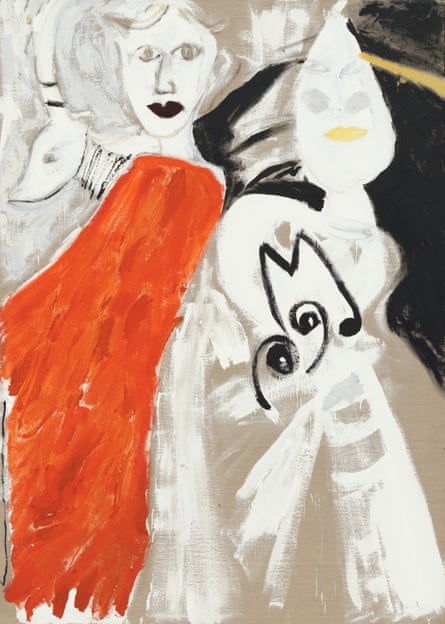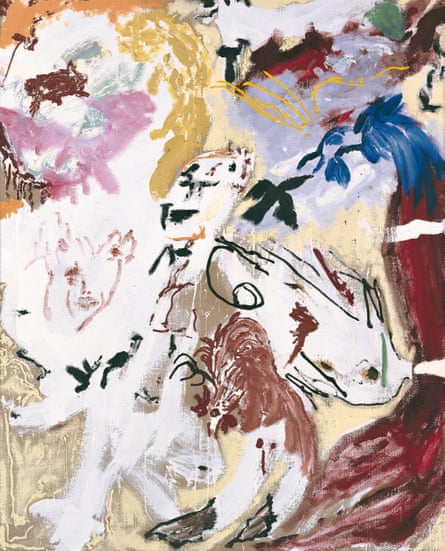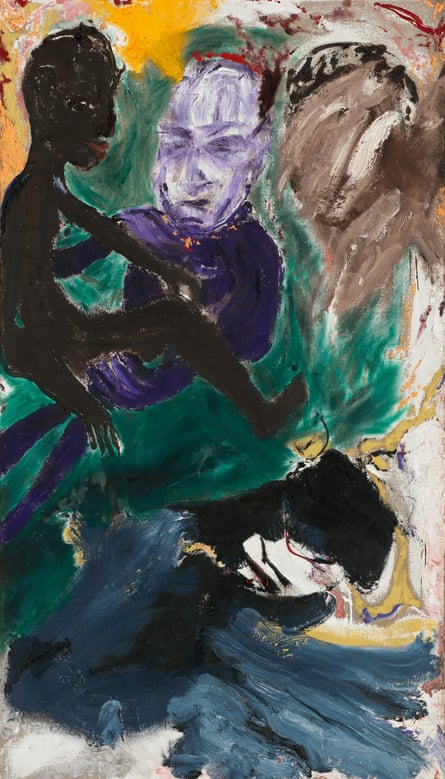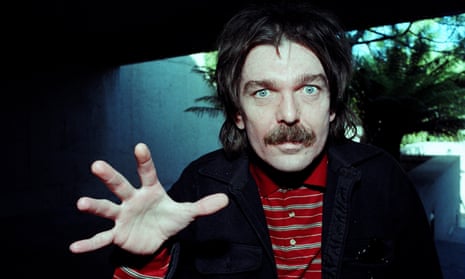Located on a street off London’s Park Lane the Michael Werner Gallery is the epitome of moneyed art world chic: situated in a Georgian townhouse, so discreet a passerby would never know it was there. It really shouldn’t be a surprise to find the late Don Van Vliet’s paintings in these surroundings – Michael Werner has been his gallerist ever since the early 80s, when Van Vliet stopped calling himself Captain Beefheart and gave up music entirely to devote himself to visual art – and yet it is. The paintings in his first London exhibition for decades feel somehow at odds with their surroundings.

Partly this is because they’re visibly a product of the wilds of California (for a time, Van Vliet lived and worked in the Mojave desert). Representations of wild animals and cacti abound, his paintings seem increasingly overwhelmed by their surroundings: the later works are filled with white space, as if blanched out by blinding sunlight. It’s partly because they seem so frenetic and untutored: wild brushstrokes, thick impastos, paint applied to canvas direct from the tube. But it’s mostly because – name change or not – they’re very obviously the work of Captain Beefheart, one of the truly legendary figures of 60s and 70s rock.
The titles often correspond with his old songs or lyrics: anyone who knows the tracklisting of his 1969 masterpiece Trout Mask Replica will recognise the name China Pig, while Crow Dance a Panther and The Drazy Hoops are taken from lines in Ice Cream for Crow and The Blimp respectively. Even when they don’t, they sound like they should: Dream Sloth, Full Grown Babble, Bird With Cotton Shadow. And, like his music – which drew on the blues and free jazz, but never really sounded much like either, or indeed anything else in pop history – it’s work that people have clearly struggled to categorise.
Reading through art journal features on his painting, you’re struck by the sense of critics wildly throwing comparisons at them in the hope that one of them sticks: Franz Kline, Mark Rothko, Jackson Pollock, expressionism, primitivism, outsider art. “Well, it’s definitely not outsider art,” says the Michael Werner Gallery’s managing partner Gordon VeneKlasen. “Because outsider art implies that somebody is making a naive body of work that happens to be interesting just by the way they make it. Don was not naive in any way whatsoever. He was aware of the history of art from the very beginning. I talked to him a lot, sometimes two to three hours a day on the phone, and there was nothing random about anything he did, any word that came out of his mouth, or any thought. He was really precise. Everything was carefully chosen. And I always felt that was the same way with the paintings.”
In a sense, the story of how Captain Beefheart, avant garde rock legend, became Don Van Vliet, visual artist begins long before he took up his famous pseudonym and formed the first incarnation of the Magic Band. He was a sculpting prodigy as a child: he won prizes, appeared on television creating animal sculptures, and – at least by his account: Van Vliet was seldom the most reliable witness to his own life story – was offered a scholarship to study art in Europe at the age of 13, which his parents forced him to decline on the grounds that art was “queer”.

He continued painting throughout his musical career – his work was used on album covers and was the subject of a 1972 exhibition in Liverpool – but you can see why it was overshadowed by the music. By the time of Trout Mask Replica, Captain Beefheart and the Magic Band sounded utterly extraordinary. Fifty-four years after its release, it remains almost invariably the most challenging listen in any Greatest Albums of All Time list, a record on which every instrument appears to be playing in a universe of its own, with only the most tangential relationship to each other. To its detractors, it barely qualifies as music. To its devotees, it was a work of unprecedented, nonpareil genius. “If there has been anything in the history of popular music which could be described as a work of art … then Trout Mask Replica is probably that work,” suggested John Peel. John Lydon called it his “confirmation”: “From then on,” he said, “there was room for everything.”
Among its fans was East German artist AR Penck, who was represented by Michael Werner. When he defected to the west in 1980, says VeneKlasen, “he kept saying, you have to find Don Van Vliet, you have to find Don Van Vliet, this is the artist you need to find. Don was his real hero.”
Penck’s suggestion presented a problem, even after Werner saw Van Vliet’s paintings and was impressed enough to propose he represent him. “It seems so normal now for somebody to have two careers,” says VeneKlasen, “but at that time in the 80s, you couldn’t be a musician and a painter, it was considered a joke. There was this gravitas surrounding the making of art and the making of music was something totally different.”
It isn’t clear who suggested that Van Vliet give up music entirely, abandon the name Captain Beefheart, and concentrate on painting. One story has Werner and Penck putting the idea it to him, another suggests it was his wife Janet, a third maintains it entirely Van Vliet’s initiative, spurred by the fact that no record label was willing to stump up enough money for a follow-up to 1982’s Ice Cream for Crow, which, per usual for Captain Beefheart, had failed to translate ecstatic reviews into sales. But if it was someone else’s idea, he didn’t need much persuading. He was, by all accounts, tired and dispirited by his musical career: he had already pulled out of a projected tour; penury had forced him and his wife to move into a trailer previously owned by his mother. “He had been quite screwed by the music business, so he kind of decided that the music business had not been very nice to him anyway and decided to give it up completely and just become a painter,” says VeneKlasen. “He was not a bitter man, but he was bitter about the music industry for sure.”
It’s tempting to wonder if there were other factors in his decision to quit music. Van Vliet’s relationship with his fellow musicians was often strained. More than one ex-Magic Band member has described him as “tyrannical”; former guitarist Zoot Horn Rollo’s book Lunar Notes paints life in the Magic Band as unmitigated misery: broke, virtually starving – they subsisted on a cup of soya beans a day – and subject to “psychological warfare” by their leader that occasionally turned into physical violence.
after newsletter promotion

The most charitable interpretation is that Van Vliet had a singular artistic vision – one involving incredibly complex and demanding music – that he was intent at achieving at all costs. But, as VeneKlasen points out, a singular artistic vision is easier to pursue if you’re the only one pursuing it. “I think he was incredibly controlling, but [the music] involved other people. And, as he got older, he really didn’t like people. I visited him once in Eureka, California – he lived up in the middle of nowhere, basically. I think painting was much more exciting for him because it was just him.”
But despite Van Vliet’s commitment to his change in career, there were issues. Encouraging Van Vliet to leave California could be a struggle: VeneKlasen tried in vain to get him to come to New York, but was met with the response that “there’s so much human skin in the air there” (Van Vliet also memorably dismissed the city as “a bowl of underpants”). His early shows were filled with Beefheart fans – “people would say ‘OK, so you talked on the phone to Don, so your proximity to him is …’,” says VeneKlasen, “almost as if he was a holy figure” – but the art establishment was dismissive. “It was very, very difficult. Jack Lane, a famous museum director, did a show at San Francisco MoMA of Don around 1986, because of his own passion for him and his work, and he almost got fired. Because everybody said ‘this is not an artist, this is a musician who makes doodles’. It’s only in the last 10 years, sadly after his death, that we’ve seen a change, and really through the eyes of other artists, not curators. I’ve talked to so many painters who look at Don’s work all the time. [German abstract painter] Charline von Heyl told me that she looks at Don’s work every morning. If you went to a curator at the Tate or any place, they’d just roll their eyes, but then if they asked the artist they respected they’d be totally shocked.”
Van Vliet kept working until his death from complications to multiple sclerosis in 2010. As his illness progressed, the gallery built him a contraption that would enable him to paint from an armchair, but he eventually switched to drawing. He never returned to music. “He was really fierce and uncompromising,” says VeneKlasen. “He did exactly what he wanted and that was it. He was a real product of a time in California, when bombs were going off and highways were being built. I mean, he told me one story where he said he was a vacuum cleaner salesman for a time, and he said he sold Aldous Huxley a vacuum cleaner!”
He laughs, and then, recalling Van Vliet’s penchant for self-mythologising and frequently tenuous relationship with the truth, offers a qualification. “I didn’t fact check it. I should probably look and see where Aldous Huxley lived in that period of time. But as a story about California at the time, I thought it was so good. It’s like Brave New World, and it’s just weird. California was weird.”

Comments (…)
Sign in or create your Guardian account to join the discussion